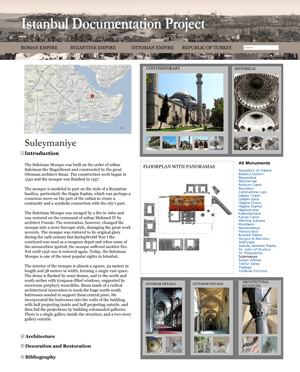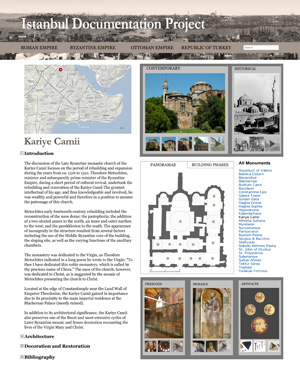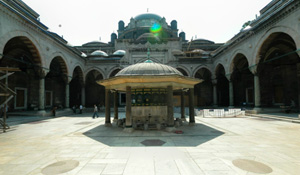
Istanbul is a city with a fascinating history that stretches over three millennia. Having served as the capital of two successive empires, namely the Late Roman or Byzantine Empire (330–1453) and the Ottoman Empire (1453–1922), it is today a rich palimpsest of cultures and artistic traditions, in which architectural monuments of its Roman, Byzantine, and Ottoman past serve as sites of historical and cultural memory woven into the ever-changing fabric of a 21st-century metropolis.
The Istanbul Documentation Project, developed by Professor Holger A. Klein of Columbia University's Department of Art History and Archaeology in collaboration with the Media Center for Art History, aims to create a digital platform for the virtual presentation of Istanbul's Roman, Byzantine, Ottoman and early Republican sites and monuments and thus provides a rich resource for scholars, students, and the general public to study the deep history of the city in preparation for site visits and as a tool for individual study, research, and teaching in the classroom.
Columbia University is inviting proposals from institutions and individual scholars, who are interested to participate in joining us in our venture. For further information, contact Professor Holger A. Klein at hak56@columbia.edu.
The Istanbul Documentation Project will create a digital monographic entry for each site or monument in the survey. These entries will present a comprehensive overview of the building and its history through essays, photographs, 360-degree panoramas, historical documents, ground plans and elevations. They will be composed and edited by specialists in their fields to serve students' and scholars' needs, yet remain flexible and open enough to incorporate input from a diverse group of researchers and collaborators in the future.
Panorama photographs of building interiors and significant historical sites were taken during the summer of 2003, during fieldwork for an earlier digital project in connection with the exhibition Restoring Byzantium. The Kariye Camii and the Byzantine Institute Restoration (Columbia University, Wallach Art Gallery, 2004). Digital photography of this kind will form an integral part of the Istanbul Documentation Project in years to come, conveying the grandeur of Byzantine and Ottoman religious architecture as well as the intimacy of domestic interiors in palaces and private houses built during later centuries. These panoramas will furthermore help to familiarize visitors with the monuments surveyed and allow for their in-depth exploration in the classroom.
Beyazidiye Mosque Complex
The Beyazidiye was the second great mosque complex built after the Ottoman conquest in 1453. It was completed between 1501 and 1506 and includes several public buildings. Its completion marks the opening of the classical imperial Ottoman style.

Kariye Camii
The former Byzantine church of the Monastery of Christ of the Chora is better known by its later Turkish name, Kariye Camii, or by its current designation as the Kariye Museum. The earliest church on the site dates back to the sixth century, was rebuilt in the late eleventh and early twelfth centuries, and restored and remodeled again from 1316 and 1321 by the Byzantine prime minister and humanist Theodore Metochites.
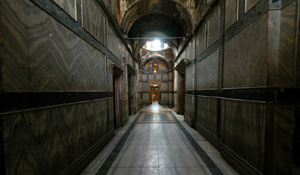
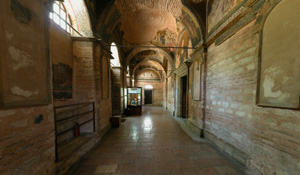
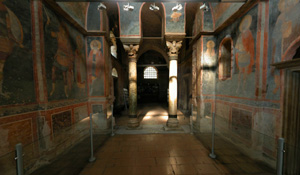
The so-called Tekfur Saray
Serving as an imperial residence during the final years of the Byzantine Empire, the palace was constructed during the late-twelfth and early-thirteenth centuries. Severely damaged during the Ottoman conquest of Constantinople in 1453, only part of the façade survives today.
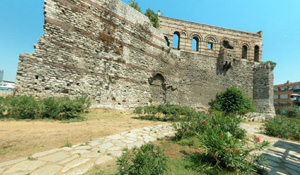
Şehzade Mosque
Built by the Ottoman master architect Sinan and dedicated to the son of Sultan Suleyman, this complex was completed in 1548. It is the first monumental imperial mosque complex serving as the model for buildings like the Suleymaniye and Sultan Ahmed.
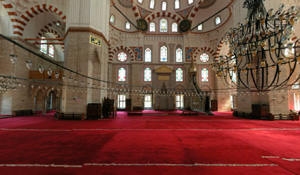
Suleymaniye Mosque Complex
Considered by many to be the finest imperial mosque complex in the city, Sinan set to work on this complex at the apex of the Ottoman Empire under the patronage of Sultan Suleyman the Magnificent, completing it in 1557.
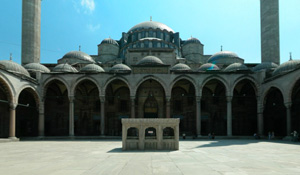
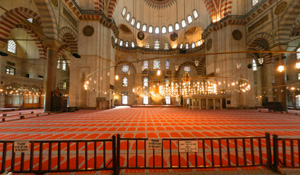
Sultan Ahmed Mosque
Built between 1609 and 1616 by Mehmet Aga under the patronage of Ahmet I, this mosque served as the focus of royal ceremony and Friday prayer for the next 250 years.
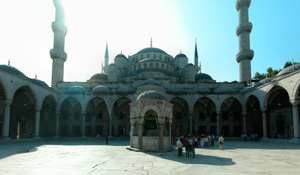
Panorama photography by the Media Center for Art History, Columbia University, Department of Art History and Archaeology.
Photo: Sebah & Joaillier, Panorama of Constantinople, taken from the Galata Tower (detail), ca. 1900.  ZOOM.
ZOOM.

